
His right foot goes down, hard. God knows how many cubic metres of cold night air and low-flying nightlife are instantly sucked into the Before part of things and, equally instantly, shot out the After end as the 5.0-litre boiler under the snout erupts. In one brief moment Kevin Bartlett is redlining and I'm seeing headlining in the shock wave of the first new GT Falcon to run the Hume Highway night in 16 years ...
Paul Cockburn, passenger's seat, north of Albury, south of midnight
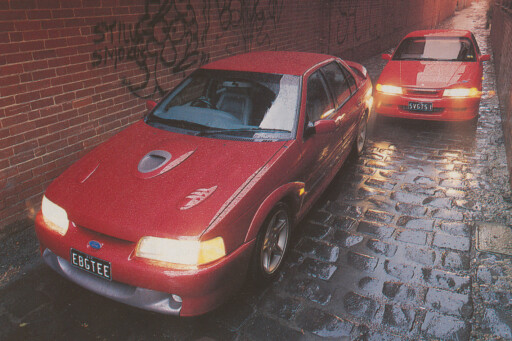
Nostalgia ain't what it used to be. Not for two cars trading on the past, on names and the glorious deeds of another place and another time.
GT and GTS. Five little letters have never meant so much. With Ford and Holden intent on bringing a whiff of touring car racing to the executive car park, cashing in on old-time cachet is suddenly back in vogue. So the revered badges have been dusted off, spit-shined and affixed to a pair of 1992 models that bear absolutely no resemblance to their ancestors ... well, except for eight cylinders apiece and a need for speed.
You know about the GT Falcon from our last issue. What we didn't tell you then, is that during the final leg of that frantic Melbourne-Sydney-Melbourne-Sydney relay in the five-speed GT, we had a Holden Commodore GTS along for the ride and, later, for head-to-head performance testing on our home circuit, Eastern Creek.
We also had an automatic GT readied for a T-bar to T-bar duel at the Lang Lang proving ground. Melbourne's foul weather intervened, rendering any shootout, at best, inconclusive; at worst, a dangerous waste of time. We chose to wait, to patiently clock up a couple of thousand kays in wet and dry conditions to get to the essence of these two '90s reincarnations.

lt was worth it. The more studied approach has produced a mountain of information and a string of contradictions. But first, it's back to the Hume, back to the future...
Full consciousness returns as Bartlett cocks approx 270 horsepower back against one and then another gear. They are held in check, waiting for the first hint of space on the coal-black road ahead. Later, out of a wet, first gear corner the back erupts into violent wheelspin and the face erupts in a smile. The official explanation is "checking for axle tramp” (none found), which would have been a good deal more plausible had he not been audibly cackling "God I'm a rock-ape” to himself.
Holden and Ford developed the original HK 327 Monaro GTS and XR Falcon GT in direct response to racing needs. Holden Special Vehicles and Tickford Vehicle Engineering didn't. lt's an important difference.
Head to head racing between GT and GTS was short-lived, but neither company mentions that these models stuttered to an inglorious end. The XB GT Falcon died a pasty-faced victim of the supercar scare, while the HZ GTS met its maker as Elvis did - overweight and out of touch. Bulging order books suggest cynicism isn't part of a '92 GTS/GT buyer's personality profile.
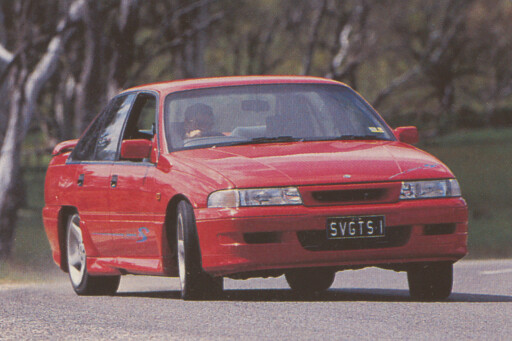
The similarities between these two are undeniable: two Australian made cars; pushrod two valve vas with origins dating back 20 odd years; both rear-drive, both developed and packaged by British-owned engineering firms.
Notable at-a-glance variations include the GTS's independent rear suspension and the sum of $7250 - the latter being the difference between the GT's $62,500 tag and the $55,250 recommended retail price for the GTS. The Ford does carry more equipment. lt's chock full of stuff you would expect to find in an LTD: walnut woodgrain, leather trim, centre console, Momo steering wheel and shifter knob, an optional CD player, power windows and mirrors, and cruise control. Even a towing kit!
The GTS shares several features, such as climate control air-con, power pack (including power steering), central locking and a trip computer, but interior trim level is optional. Ours came with 'Devenish' seats and matching cloth interior, with GTS emblems on the door trims, bumping the price up by $1500. Instruments are Calais fare, the auto shifter and centre console is standard Holden ware, save for suede trimming.
The significant parting of the ways is with transmissions. The GT offers both manual and auto, while the GTS is automatic-only. HSV says the Borg Warner T5 manual can't cope with the GTS's 410 Nm, that the T700 auto alone will handle such potent twisting forces. Yet Ford's GT dumps 420 Nm onto its Borg Warner T5, albeit modified with 1993 Mustang Cobra gear clusters and upgraded bearings.
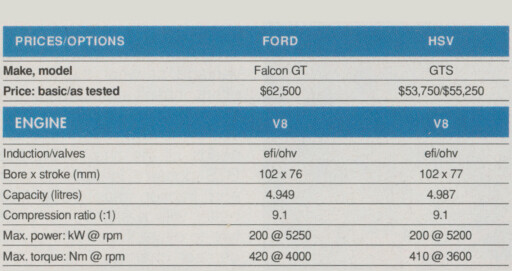
The engine specs underscore the evenness of the contest. The bore/stroke equation is practically identical, with the GT a single millimetre shorter in stroke only. Both quote 200 kW peaks, the GT's arriving 50 revs later than the GTS's 5200 rpm maximum. As mentioned, 410 Nm for the GTS (at 3600 rpm), 420 Nm at 4000 rpm for the GT. Both share a 9.1 compression ratio, knock sensors, iron heads, iron blocks and roller rockers. On paper, barely a hair's breadth between them. On the track, our figures suggest it's the GTS that does the better job.
The 4.30 am start has no-one all that thrilled. KB cheers himself up by checking for axle tramp again (three times, none found) and does his best at several traffic lights to encourage Mr Page in the GTS to the same precaution. The lad finally sees the wisdom as we enter a long, straight road not a million miles from the front door of the Ford Motor Companys head offices. All hell erupts as both cars are simultaneously examined for tractive ability. The home team gains the early lead but, hopefully out of sight of the admin block, it is the Holden that takes the event, Mr Page sailing past with one finger raised ever so nicely.
Despite driving through its automatic trans, the Maranello Red Holden holds the five-speed GT's shirt-tails through all set-piece disciplines. The HSV product requires delicate use of the throttle to avoid overpowering the rear end on launch, but once in the groove, the GTS matches the GT through the 60, 1 00 and 120 km/h standing start benchmarks. Only when the pair hits the 140 km/h mark does the GT start to draw away, its 13.4 secs eclipsing the enemy by 0.7 secs. The standing 400 metres is similarly depressing for Ford diehards, with the GTS just nudged out 15.2 to 15.3 secs, with a one kay-per-hour gap in terminal speeds.
Looking back over our notes, it's significant that the Falcon's engine doesn't feature heavily. lt's civilised all right, but one wonders if it doesn't need more bite. After one 12 hour session behind the wheel, we were left with an overriding impression of efficiency and a belief that Ford kilowatts and newton metres must be smaller than their General Motors kin.
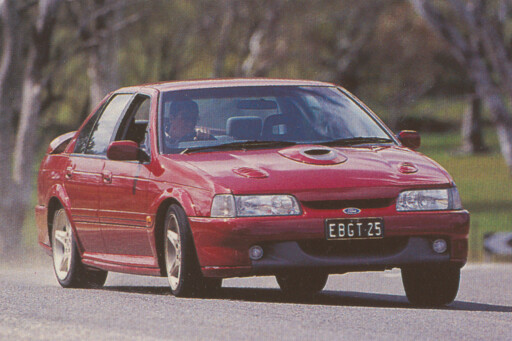
This ersatz Mustang Cobra engine is a mostly refined, smooth engine that belies its pushrod configuration. There's whisper of cammy jiggery-pokery at idle, but this disappears the second the engine is loaded. There's more than enough overtaking urge in third, fourth and even fifth gears, but first and second will disappoint those reared on rubber-melting GTHOs. The '92 GT is all about linear progression from rest. You feel quietly impressed, rather than taken aback.
Despite its automatic transmission - and the fact that it takes the GTS that bit longer to spool up - the Commodore feels meatier, punchier down low. If you can keep traction up to the car, that is. IRS and all, the GTS is keen to get those rear boots zinging in the wet, particularly when turning 90 degree corners. Attention must be paid to steering angle and how quickly you crack open the throttle, a characteristic of IRS, according to co-tester Kevin Bartlett.
At the top of second gear, the GTS starts to haul in the GT. Its mid-range urge feels to shade the Falcon's, giving it an accelerative momentum that’s hard to break. Where the Falcon's winding up, the GTS is running. Making power without making noise (exhaust or induction) isn't easy, but the Holden 5.0 litre V8 still manages to tingle the senses with its deep, yesteryear note when pulling hard. The GT's SVO engine keeps its higher pitched, more polished image, merely getting on with the job of rocketing down the road rather than giving a hard-on. The GT lets its tyres and suspension do that.
Where Australian performance cars of yore cocktailed three parts engine and a dash of chassis, the 1992 GT kicks the other way. Simply, it has more grip than we imagined you could extract from a roadworthy Falcon, and arguably more than the engine can exploit. lt's now well documented that TVE's engineers started with the Pirelli P Zero tyres, and worked back. HSV originally released the GTS with Dunlop D40 M2s, but has since included a Pirelli P Zero upgrade in what looks like a knee-jerk response.
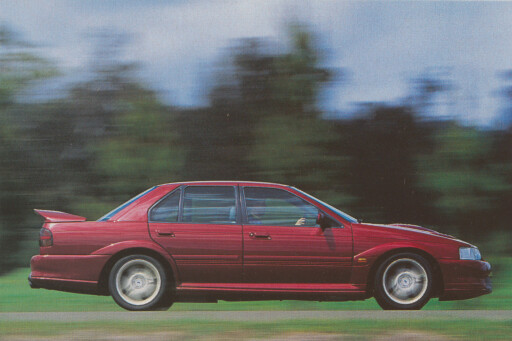
The purpose-driven nature of TVE's work shows when you get the pair back to back. Where the Falcon is stiff, taut and turning in effortlessly, the GTS is turning in then wanting to understeer. Its limit arrives earlier, and with warning. But this is high speed stuff, requiring a racer's skills to fully deploy both cars' capabilities.
Crispness of response and the technology around the rims impress most about the Falcon. The GT is engineered right up to and including the tyre; the Commodore isn't. HSV hasn't taken full advantage of what the P Zero offers, hasn't recalibrated the suspension tune to make best use of the- new rubber. The GT needs all the tyre, where the GTS doesn't; in fact, its rear end traction may be a little better with a slightly narrower tyre to offset the effects of IRS camber change. The GT exploits the tyres' grip better. Its heavy front anti-sway bar and its springs are better matched to the Pirellis, where the Commodore front end bites, then gets down on the bump rubber and starts to understeer.
Having driven the Falcon throughout proceedings, I have come to favour it. Time spent in the Holden has shown up its less-than-overt sensuality and its taxi-issue interior. lt has left me cold. But now, in the final hour of this exercise, I am driving it down the roads I know well ... roads that lead home ... and loving it. Over the broken-surface the ride is poised and well-silenced, the road-holding damn good and the engine, the engine Lord Love Us, even driving through an automatic transmission, has a top-end rush that could lead to sin.
Directional stability is a win to the GT. Where the GTS is keen to tramline under most conditions and bump steer when cornering or braking, the GT is more assured, less inclined to take interest in every nuance of road surface deviation. lt's not quite a BMW M5, but it's not half bad, either.

Both cars steer well although heavier efforts are required with the GTS. The gap narrows once you're moving at reasonable speeds. The GT retains the XRB's razor sharp reaction just off centre, which takes kays to grow used to.
The Falcon's stiffer front end is evident at almost all speeds, but more noticeable when cruising at open road velocities. Simply, the GTS is a more comfortable ride for a longer period of time. Nicer. Not necessarily more inspiring, but definitely less jolting over those typically annoying small blips in the bitumen.
TVE has done an excellent job of isolating the solid rear axle from its vices, and it is the front end that's intrusive by comparison. This is no major issue for what is, after all, a sports tourer, but if a Melbourne-Adelaide (or similar) trip were to be undertaken, the GTS would be the less bodily disturbing experience.
Seats are part of that equation, but the GTS doesn't score a clear victory. More heavily bolstered and, arguably, more suited to the niche than the GT's flatter, leather clad buckets, the GTS loses out with its driving position. Okay, there's seat height adjustment, but the Falcon offers column tilt and reach, which delivers a more precise driving position.
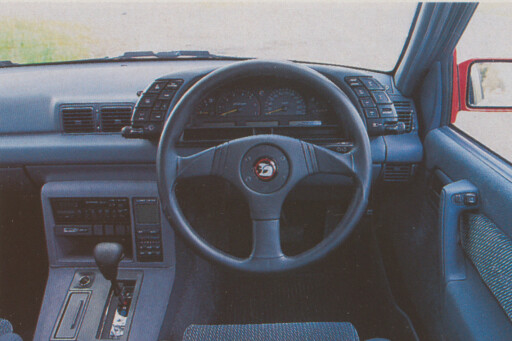
The GT disappoints when your left hand falls to the shifter. The long throw five speed is the GT's least appealing feature. The indistinct gate, rubbery movement and generally fragile gear-feel offer no joy. The GTS and its automatic live in peace. The firmer upshifts are well timed, and the T700 isn't reluctant to slot back quickly and efficiently from fourth to third. HSV has taken torque convertor lock-up from 64 km/h to 88 km/h.
So, GT or GTS? A tough decision, but as we tested them, in manual versus auto form, we'll score a very tight win to the GT, the decisive factor its chassis poise and refinement. We'd like more performance please, and we'd like a Hurst shifter.
The GTS? lt's marginally slower than the manual GT but that's no cause for shame. It has more of the feel-good factor, makes better noises but ultimately doesn't handle and point quite as well. In an ideal world we'd like the HSV engine in the Ford rolling chassis.
Just as Madonna will never be Marilyn, the GT and GTS can't bridge two decades of change. But those five old letters certainly spell a refined new blend of muscle and panache. Nostalgia with style.
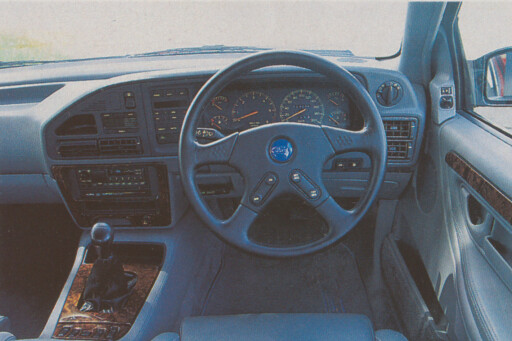
The Ford feels firm, muscular, and, with its cramped leg room and dark interior, small. It’s intense. The Holden is more easy-going and cheery; lighter in character and mass but no less brawny. No sir. Neither are the single-dimension rockets of yesteryear, both are backroad blasters of very high order indeed. The GTS may look as dopey as the Ford ... no, make that even dopier ... but behind the wet-dream wings and whack-ons the boy has real talent. They both do. But its up to the grown-ups to judge which does it best. We part that night satisfied with the doing of a long, hard job.

COMMENTS